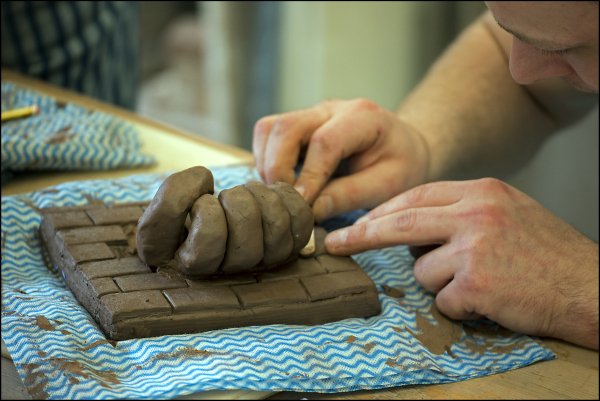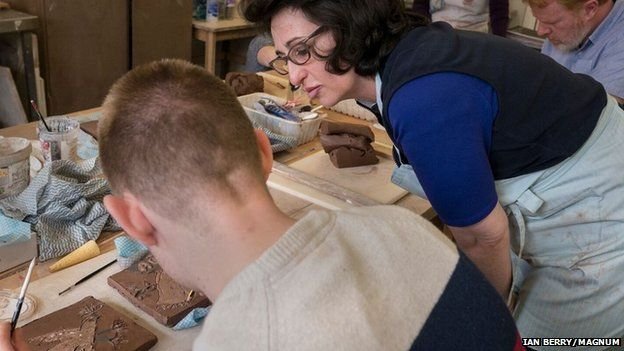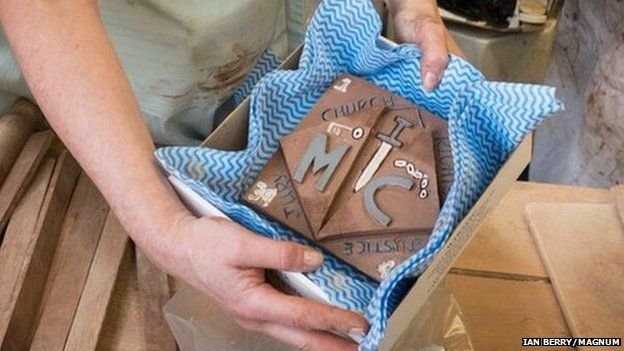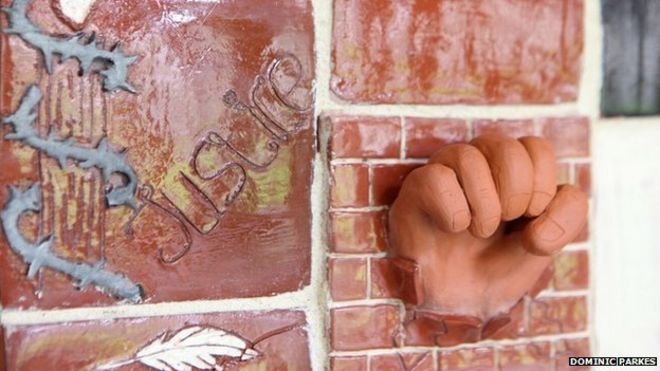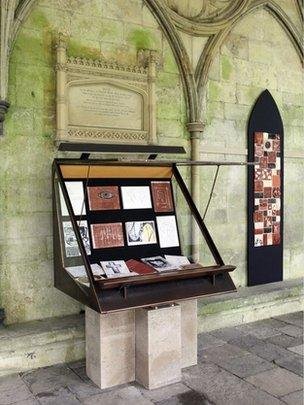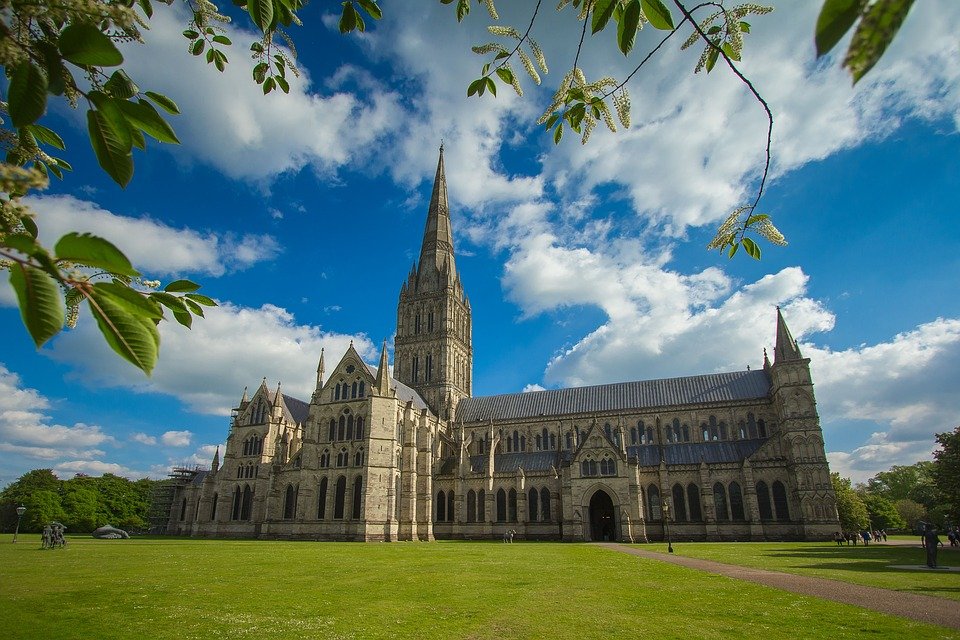Salisbury Cathedral
Installation with a focus on community participation and education
Salisbury Cathedral is the Cathedral Church of the Salisbury Diocese which spans areas in both Wiltshire and Dorset. The Cathedral defines its roles in terms of worship, outreach, providing access to heritage and connecting with the various communities to which it belongs. The Cathedral Chapter acknowledges art as an incitement for spiritual and intellectual practice and is dedicated to using the Cathedral space for installations. The Cathedral also aims to use art to explore difficult topics relating to social justice.
A collaborative project with inmates at Erlestoke prison, ‘Alternative Perspectives’, explored ideas of justice through collaborative work with inmates in commemoration of the 800th anniversary of the Magna Carta, of which one of four original copies is housed at the Cathedral.
The ‘Alternative Perspectives’ exhibition formed part of a wider series of exhibitions and events planned to celebrate the Magna Carta’s 800th anniversary in 2015. The exhibition related themes of justice, law, human rights and power. The project with inmates at Erlestoke was conceived and coordinated by the Cathedral’s Visual Arts Advisor, Jacquiline Creswell, along with Sarah Rickett (Director of Learning and Outreach), Sarah Mullally (Canon Treasurer) and a small group of volunteers. Over the course of several months, workshops were run with inmates in which they fashioned ceramic artworks with ideas of justice in mind. Once completed, the works were installed in the Cathedral’s Cloisters alongside the sketchbooks used by the inmates in the development of their designs.
‘‘Alternative Perspectives’ explores rights and justice from the point of view of offenders … It has produced some thoughtful and exciting work from a fresh perspective.’ Jacquiline Creswell, Visual Arts Advisor, Salisbury Cathedral
Objectives of connecting with a community with limited access to the arts, producing artworks relevant to current social issues and engaging with social justice were at the heart of the ‘Alternative Perspectives’ project. The exhibition had a lasting impact on the Cathedral and the community. Ongoing work with the group of inmates at Erlestoke attests to the capacity of this kind of arts project to occasion sustained engagement with a marginalised community.
Salisbury Cathedral was first consecrated in 1220, and the Cathedral has evolved significantly over the centuries since its existing structure was instansiated. The Early English Gothic style chapter house displays its copy of the Magna Carta which was the starting point for ‘Alternative Perspectives’. The 800th anniversary festival created a unique atmosphere for the project alongside the Cathedral’s physical setting as a grand, historic space.
The Magna Carta anniversary celebration was a large project funded by the Heritage Lottery Fund. Multiple art exhibitions as well as lectures, theatre, music, workshops and worship took place over the course of several weeks. Although the project as a whole was large scale, the ‘Alternative Perspectives’ installation allowed for more intimate societal relationships to be developed between parish, prison and the wider community.
Description
The process of commission and installation for any artwork at Salisbury Cathedral involves a team who works with the Visual Arts Advisor to include the congregation as well as relevant community groups. All projects have an element of outreach. Funding for ‘Alternative Perspectives’, which had a small budget, was raised through the Friends of Erlestoke as well as the Friends of the Cathedral. Terracotta tiles were made in the style of those found in the Cathedral, with a black and white slip used to mimic medieval counterparts. Workshops were held at Erlestoke, in which around 26 inmates participated. Sketches were made initially, and those designs were then crafted in terracotta, glazed and fired. These were then assembled by Creswell into montages that were hung in the cloisters alongside the artists’ sketchbooks, which were displayed in a glass case. The project was marketed together with other events for the anniversary celebrations but radio and other news coverage focused especially on ‘Alternative Perspectives’ due to the involvement of the Erlestoke inmates. Installation and deinstallation were both managed by Creswell with the help of the Cathedral’s Works department.
Because of her experience with installations in listed buildings Cresswell was able to confidently navigate the space. Commenting on constraints when exhibiting in heritage, sites Creswell said:
‘When you are put in the position where you are so limited in what you can do … you have to be so creative and that can be such a positive difference … there is always a way to make it work.’
A book was displayed alongside the artworks for visitors to leave comments. After the exhibition, the montages, along with the visitor log, were transported to the visitor’s area at Erlestoke where the inmates could admire their finished work and read the responses from visitors.
Appraisal
The exhibition is regarded as a success by those involved. Intended to provide inmates with the means to explore ideas of justice through the Magna Carta, its collaborative nature was perhaps the biggest success of all. The continued partnership between Erlestoke and Salisbury Cathedral demonstrates the degree to which this project succeeded in its goal of bridging the barrier between inmates and the wider community.
When asked what she might change if she had the chance to organise the project again, Creswell responded that she would have liked to have run parallel workshops at which participants outside the Erlestoke community could have made their own ceramic artworks. Creswell was interested in how those might have compared with those made by the inmates, and would have used this as basis for a dialogue between the two groups.
‘It’s helpful to do these things in prison I think because it is refreshing to know that even though you are in prison you can still be a functional part of society in some small way’ Erlestoke project participant
‘This isn’t just an art project, its implications are far broader. The art sessions function as a forum in which we managed to get the prisoners to really think about issues such as human rights and wrongs, and the justice system. The feedback we have got has been powerful ... It has been a learning experience for them and for us.’ Elizabeth Williams, Learning & Skills Manager, HMP Erlestoke

